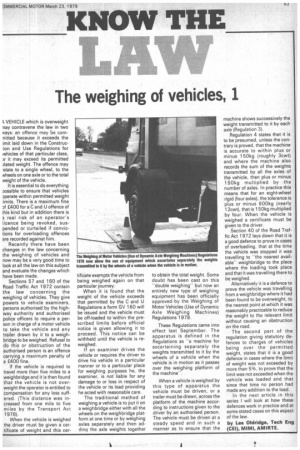The weighing of vehicles, 1
Page 65

If you've noticed an error in this article please click here to report it so we can fix it.
\ VEHICLE which is overweight nay contravene the law in two tvays: an offence may be cornnitted because it exceeds the imit laid down in the Construcion and Use Regulations for tehicles of that particular class, )r it may exceed its permitted plated weight. The offence may .elate to a single wheel, to the tvheels on one axle or to the total tveight of the vehicle.
It is essential to do everything possible to ensure that vehicles pperate within permitted weight imits. There is a maximum fine Pf £400 for a C and U offence of this kind but in addition there is 3 real risk of an operator's licence being revoked, suspended or curtailed if convictions for overloading offences are recorded against him.
Recently there have been changes in the law concerning the weighing of vehicles and now may be a very good time to look at all the law on this subject and evaluate the changes which have been made.
Sections 57 and 160 of the Road Traffic Act 1972 contain the law concerning the weighing of vehicles. They give powers to vehicle examiners, persons authorised by the highway authority and authorised police officers to require a person in charge of a motor vehicle to take the vehicle and any trailer drawn by it to a weighbridge to be weighed. Refusal to do this or obstruction of the authorised person is an offence carrying a maximum penalty of a £400 fine.
If the vehicle is required to travel more than five miles to a weighbridge and it is then found that the vehicle is not overweight the operator is entitled to compensation for any loss suffered. (This distance was increased from one mile to five miles by the Transport Act 1978).
When the vehicle is weighed the driver must be given a certificate of weight and this cer tificate exempts the vehicle from being weighed again on that particular journey.
When it is found that the weight of the vehicle exceeds that permitted by the C and U Regulations a form CV 160 will be issued and the vehicle must be off-loaded to within the prescribed limits before official notice is given allowing it to proceed. This notice can be withheld until the vehicle is reweighed.
If an examiner drives the vehicle or requires the driver to drive his vehicle in a particular manner or to a particular place for weighing purposes he, the examiner, is not liable for any damage to or loss in respect of the vehicle or its load providing he acted with reasonable care.
The traditional method of weighing a vehicle is to put it on a weighbridge either with all the wheels on the weighbridge platform at one time or by weighing axles separately and then adding the axle weights together to obtain the total weight. Some doubt has been cast on this "double weighing" but now an entirely new type of weighing equipment has been officially approved by the Weighing of Motor Vehicles (Use of Dynamic Axle Weighing Machines) Regulations 1978.
These Regulations came into effect last September. The apparatus is defined in the Regulations as "a machine for ascertaining separately the weights transmitted to it by the wheels of a vehicle when the vehicle is in motion as it passes over the weighing platform of the machine".
When a vehicle is weighed by this type of apparatus the vehicle must be driven, or a trailer must be drawn, across the platform of the machine according to instructions given to the driver by an authorised person. The vehicle must be driven at a steady speed and in such a manner as to ensure that the machine shows successively the weight transmitted to it by each axle (Regulation 3).
Regulation 4 states that it is to be presumed, unless the contrary is proved, that the machine is accurate to within plus or minus 150kg (roughly 3cwt) and where the machine also records the sum of the weights transmitted by all the axles of the vehicle, then plus or minus 150kg multiplied by the number of axles. In practice this means that for an eight-wheel rigid (four axles), the tolerance is plus or minus 600kg (nearly 12cwt), that is 150kg multiplied by four. When the vehicle is weighed a certificate must be given to the driver.
Section 40 of the Road Traffic Act 1972 lays down that it is a good defence to prove in cases of overloading, that at the time the vehicle was stopped it was travelling to "the nearest available" weighbridge to the place where the loading took place and that it was travelling there to be weighed.
Alternatively it is a defence to prove the vehicle was travelling from a weighbridge where it had been found to be overweight, to the nearest point at which it was reasonably practicable to reduce the weight to the relevant limit without causing an obstruction on the road.
The second part of the regulation giving statutory defences to charges of vehicles being over the permitted weight, states that it is a good defence in cases where the limit of weight was not exceeded by more than 5%, to prove that the limit was not exceeded when the vehicle was loaded and that since that time no person had made any addition to the load.
In the next article in this series I will look at how these defences work in practice and at some stated cases on this aspect of the law.
by Les Oldridge, Tech Eng (CEO, MIMI, AMIRTE.
















































































































